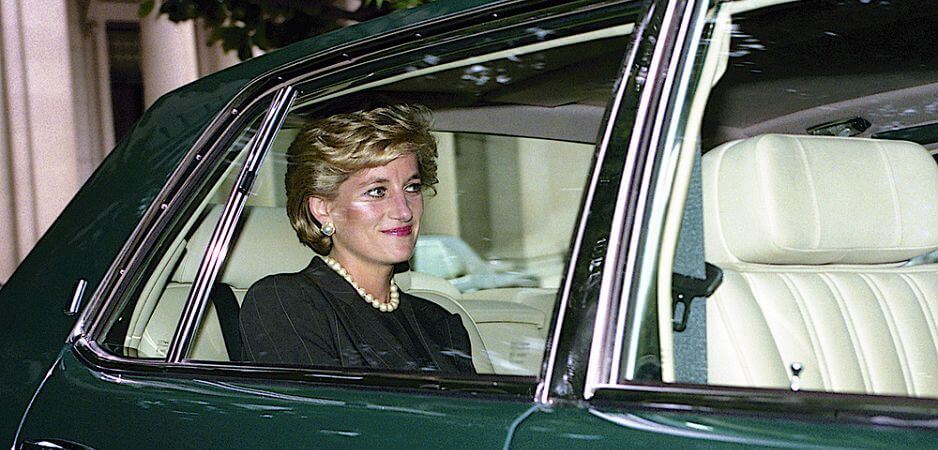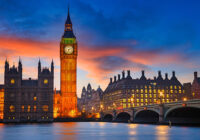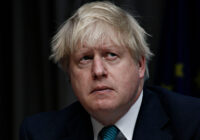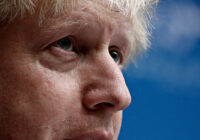Even the most sober account of her life and death seems like a fairytale that got out of hand.
In March 1982, there was a charity preview of the Lillian Hellman play The Little Foxes at London’s Victoria Palace. The star of the show was Elizabeth Taylor, playing her first full stage role.
Making a late entry into the theater’s Royal Box was Diana, Princess of Wales, then pregnant with her first child. “It seemed impossible that anyone would ever manage to upstage the Princess of Wales, but in the last two weeks, a 50-year-old woman with a turbulent past and an uncertain future has succeeded in doing so,” advised R.W. Apple Jr. of The New York Times.
It was the last time anyone would upstage Diana. She would blaze her way transcendently into history, mainly through her charity work and her media appearances, but also because of her troubled, loveless marriage. Diana was a kind of heiress apparent to Taylor: fame and notoriety overlaid and invaded both of their lives. If Taylor created what film critic Dave Kehr calls “a new category of celebrity,” Diana became its distillation.
Apple Jr. described how Taylor’s arrival in London two weeks before the preview “prompted a riot among news photographers” and that her every move from that point had been chronicled by the British media. He was writing for a New York newspaper, of course. Four years later, when Diana made her entrance to the US, the scenes were comparable.
Diana swept into Washington, DC, to attend a gala dinner at the invitation of President Ronald Reagan and his wife Nancy in 1985. She mixed with movie stars and politicians, danced with John Travolta while Americans watched in rapture. Diana had her critics, but the unseen emotions she seemed to radiate had powerful effects. To her countless acolytes she was a force of nature, animating the spirits of whomever she touched, bringing vitality to wherever she traveled. Twelve years later, she was gone.
LADY SPENCER
Diana had married Prince Charles in 1981. She was divorced in 1996, the year before her death. Long before that, Diana had reconciled herself to being unique and unrivaled as the paparazzi’s favorite subject. Up till her arrival, interest in the British royal family had for long been largely reverential. Onlookers were exactly that: detached observers, watching as subjects rather than participants. Only Queen Elizabeth’s sister, Princess Margaret, induced a more involved curiosity — her trysting occupying the paparazzi, though without sending them into frenzy as Diana did.
Born in 1961 at Park House, the home that her parents rented on Queen Elizabeth II’s Sandringham estate, Diana was the third child of Edward John Spencer, Viscount Althorn, heir to the seventh Earl Spencer, and his first wife Frances Ruth Burke Roche, daughter of the fourth Baron of Fermoy. So, her aristocratic credentials were sound.
She became Lady Diana Spencer in 1975, when her father became an earl. Returning to England after finishing school in Switzerland, Diana grew close to Prince Charles. They announced their engagement in February 1981 and married later that year. The wedding ceremony was televised globally. Their first child, William, was born in 1982 and their second, Henry, or Harry as he was to become known, in 1984.
Over the next eight years, interest in Diana went global. Already the most admired and, perhaps, accepted member of the royal family, she contrived to remain imperious while developing a common touch. Time and again, people would testify that “she touched me” even though they might never have met her or seen her in the flesh. There was a tangible quality not so much in her presence, but in even her sheer image. And this was made possible by exhaustive media coverage that occasionally, in fact once too often, became dangerously invasive.
Diana was a beautiful, yet lonely princess imprisoned in a loveless marriage with a prince whose suspected infidelity with an older and less attractive woman was the talk of the court. Trapped and with no apparent escape route, she seemed defenseless against a powerful and uncaring royal family. Diana made an enchanting victim, a vision of mistreated womanhood smiling serenely at her millions of faithful followers.
Her popularity seemed to grow in inverse proportion to that of her husband. Diana threw herself into charitable work and aligned herself with great causes, visiting people living with AIDS, children in hospitals and other sufferers, all of whom responded empathically. People, especially women, from everywhere were drawn to someone who, in her silence, seemed to speak for everyone.
WORST KEPT SECRET
The separation was one of those worst kept secrets. When it was finally announced in 1992, both Diana and Charles continued to carry out their royal duties. They jointly participated in raising the two children. Diana continued with her charitable endeavors, attracting battalions of photojournalists wherever she went. If there was a high point during this period, it came in January 1997 when, as an International Red Cross VIP volunteer, she visited Angola to talk to landmine survivors. Pictures of Diana in a helmet and flak jacket were among the most dramatic images of the late 20th century. In August, she traveled to Bosnia, again to visit survivors of landmine explosions. From there she went to see her companion, Dodi al-Fayed, in France.
Late in the evening of August 30, 1997, Diana and al-Fayed, their driver and bodyguard left The Ritz hotel in Place Vendôme, Paris and drove along the north bank of the Seine. Ever vigilant, the media were soon alerted and pursued the Mercedes in which the party was traveling. Remember, by 1997, Diana’s every movement was closely monitored. Interest in every aspect of her life was genuinely global. Not only was she fêted the world over, she was inspected too. At 25 minutes past midnight, nine vehicles carrying the media and a single motorcycle followed Diana and al-Fayed into an underpass below the Place de lama. As the Mercedes sped away from the pursuant pack, it clipped a wall and veered to the left, colliding with a supporting pillar before spinning to a halt.
There followed a few moments while the chasing photographers paused to consider their options. Inside the wrecked Mercedes were four motionless bodies, including that of the world’s most famous, most esteemed, most adored, most treasured and most celebrated woman. Photos of the wreckage would be hard currency. But to delay helping her and her fellow travelers might jeopardize their chances of survival. The paparazzi took their shots.
Diana was still alive when she was freed and rushed by ambulance to a nearby hospital. Attempts to save her life were futile and, at 4am, doctors pronounced her dead. Of the Mercedes passengers, only Trevor Rees-Jones, al-Fayed’s bodyguard, survived. None of the others were wearing seat belts. It was later revealed that the chauffeur, Henri Paul, had been drinking earlier in the evening. The media people were cleared.
OUTPOURING OF EMOTION
There followed the most extraordinary expression of public grief ever. This is unarguable: The scale, scope and intensity of the response to her death distinguished it from any comparable manifestation of sorrow. The response to Diana’s death is usually described as an “outpouring of emotion,” suggesting an unrestrained expression of heartfelt grief all over the world. In the days leading up to her funeral on September 6, over a million people flocked to pay their last respects, many leaving bouquets at her London home at Kensington Palace. Her funeral attracted 3 million mourners who cast flowers along the entire length of the journey. A global television audience of 26 million watched the day’s events.
 A foretaste of the exploitability of Diana came when the first issue of Time magazine following her death sold 750,000 more copies than usual. Sales of a commemorative issue exceeded 1.2 million. The National Enquirer, in a somewhat hypocritical gesture, refused to publish pictures of Diana’s death scene, despite having headlined a cover story the week before, “Di Goes Sex Mad.” The copies were pulled from the newsstands.
A foretaste of the exploitability of Diana came when the first issue of Time magazine following her death sold 750,000 more copies than usual. Sales of a commemorative issue exceeded 1.2 million. The National Enquirer, in a somewhat hypocritical gesture, refused to publish pictures of Diana’s death scene, despite having headlined a cover story the week before, “Di Goes Sex Mad.” The copies were pulled from the newsstands.
Then came the merchandise. A planned comic book featuring Diana raised from the dead and invested with superpowers and entitled (following the James Bond movie) Di Another Day was ditched by Marvel Comics amid protest. But less offensive products such as statuettes, decorative plates and Cindy-like dolls began to appear on the shelves within months of the tragedy. The near-inevitable conspiracy theories surrounding the death were equal to those of the moon landing, the JFK assassination or 9/11.
More rational attributions of blame centered on the chasing pack of paparazzi. Diana’s brother, the Earl of Spencer, offered this view: “I always believed the press would kill her in the end. Every proprietor and editor of every publication that has paid for intrusive and exploitative photographs of her, encouraging greedy and ruthless individuals to risk everything in pursuit of Diana’s image, has blood on his hands.”
If the paparazzi had not been so voracious in their attempts to track down Diana, they would not have pursued her car so heedlessly. So went the argument. Few wanted to extend that same argument further. If they had, they would have concluded that the paparazzi were motivated by money offered by media corporations that could sell publications in their millions to consumers, whose thirst for pictures and stories of Diana seemed unquenchable. In the event, the photographers were cleared of any wrongdoing by a French court in 1999. The fact remains: All parties, from the paparazzi to the fans, were connected as if by invisible thread. And then something interesting happened.
NARRATIVE TRANSFORMATION
The audience not only watched the Diana fairytale reach its denouement, but saw themselves as bit part players in that same fairytale. This narrative transformation was both revealing and concealing. The media’s part in the death of Diana might have been laid bare, but audiences’ complicity, though recognized, was left unexamined, at least not in a deep or critical sense. While audiences might have agreed with the Earl of Spencer and condemned the media, they rewarded them with high sales and record viewing figures.
Perhaps transformation overstates the change. Anyone who was aware of Diana — and it’s difficult to imagine anyone who was not — was forced to inspect the way in which news values had been subverted by entertainment values. After all, Diana’s greatest triumph was not so much in ushering in world peace or saving the planet, but in offering so much pleasure to so many people.
Yet the inspection was momentary. It did not bring to an end the gathering interest in figures who, like Diana, offered pleasure while presenting absolutely nothing that would materially alter their lives or the lives of any other living thing. The interest in recognizable people was probably interrupted by Diana’s death. Then, after a spell of earnest introspection and critical evaluation of the media, the interest resumed.
In the 1960s, when Elizabeth Taylor was the world’s most famous, most scandalous and perhaps most revered woman, the most adventurous clairvoyant would have been hard pressed to predict the tumult of interest in Diana. Diana was news: not just what she was doing or saying or even wearing; people seemed to gasp in wonder at the very mention of her name.
Something happened. Not to Diana, but to us. We, the living human beings who attributed her with so much celestial power, were the ones who changed. And, after her death, we would go on changing. Following the death of Diana and al-Fayed, Time magazine writer Margaret Carlson observed: “By the time of the couple’s dinner at Paris’ Ritz Hotel, the rules of engagement sometimes observed between the photo hounds and the princess had gone completely by the board, as the street value of a grainy shot of Diana with al Fayed reached six figures.”
Carlson’s phrase carries connotations of the principles that bind the actions of parties involved in some sort of conflict or competition. That was not the case here, though the circumstances of Diana’s death certainly had the elements of opposition. Carlson’s point is that “the run-ins between celebrities and those who take pictures of them are growing increasingly ugly.”
The paparazzi were not exactly received with open arms by stars of the 1960s, but they became parties to an initially uneasy accommodation, which later became symbiotic, benefiting both.
The glare may have tormented Diana, but her children, William and Harry, learned to live with it, both in their different ways, responding to an environment populated by an expanding number new species of the paparazzi genus.
There were other evolutionary diversifications. For example, the National Enquirer and other tabloids with their relentless focus on the exploits of famous personalities were reducing the scope of world events to individuals. We, in turn, became habituated to a softening of news in which entertainment — and I use this in its widest sense: anything that amuses or occupies us agreeably — became an increasingly large staple in our intellectual diets. Our interest in politics took on a personal focus, as we were drawn to politicians as much if not more than their politics.
We started to understand the world through people rather than events, processes or actions. Interest that, in the 1960s and perhaps 1970s, would have been seen as unwholesome or downright salacious became much more commonplace. The scandals precipitated by Taylor’s affairs may not have started this, but Diana’s emergence was the single most important episode in the transition to a culture in which almost everything we knew arrived via the media and everything we did was designed to take us closer to a life of endless novelty, pleasure and consumption.
As celebrities go, Diana was ne plus ultra — the highest form of such a being. No woman or man had ever commanded such reverence, respect and collective love from such a wide constituency, in her case the world. Even the most sober account of her life and death seems like a fairytale that got out of hand. It has the staples of love and death, as well as liberation, tragedy and immortality. Like most great fairytales, its central motif was transformation.
As raggedy servants are transformed into glass-slippered belles of the ball, and sleeping beauties are awakened by the kiss of handsome princes, Diana was changed from ingénue kindergarten teacher in a London school to the nearest the 20th century had to a goddess.
*[Ellis Cashmore is the author of Elizabeth Taylor: A Private Life for Public Consumption.]
The views expressed in this article are the author’s own and do not necessarily reflect Fair Observer’s editorial policy.
Photo Credit: Mark Reinstein / Shutterstock.com
Support Fair Observer
We rely on your support for our independence, diversity and quality.
For more than 10 years, Fair Observer has been free, fair and independent. No billionaire owns us, no advertisers control us. We are a reader-supported nonprofit. Unlike many other publications, we keep our content free for readers regardless of where they live or whether they can afford to pay. We have no paywalls and no ads.
In the post-truth era of fake news, echo chambers and filter bubbles, we publish a plurality of perspectives from around the world. Anyone can publish with us, but everyone goes through a rigorous editorial process. So, you get fact-checked, well-reasoned content instead of noise.
We publish 2,500+ voices from 90+ countries. We also conduct education and training programs
on subjects ranging from digital media and journalism to writing and critical thinking. This
doesn’t come cheap. Servers, editors, trainers and web developers cost
money.
Please consider supporting us on a regular basis as a recurring donor or a
sustaining member.
Will you support FO’s journalism?
We rely on your support for our independence, diversity and quality.






